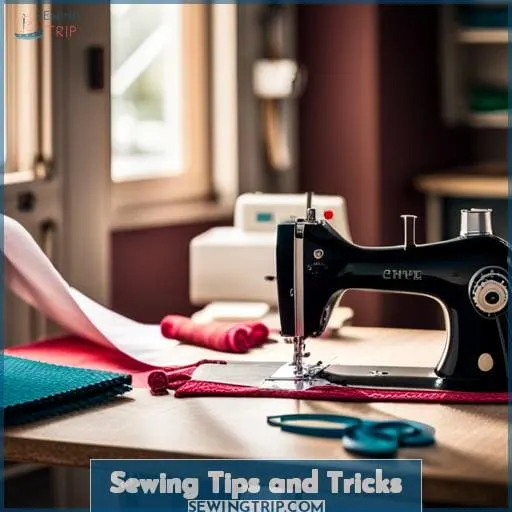This site is supported by our readers. We may earn a commission, at no cost to you, if you purchase through links.
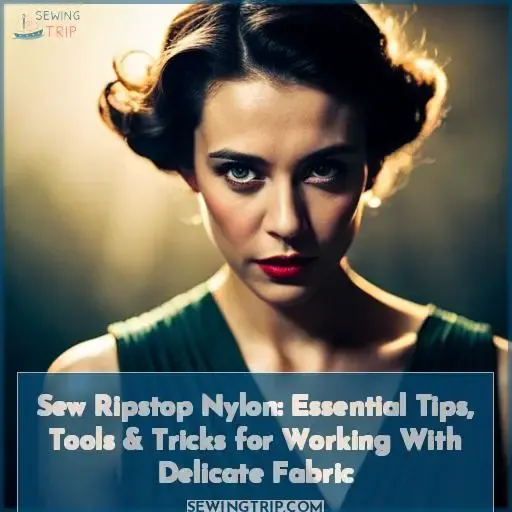 Ripstop calls for special handling, so grab your best needle and steady your machine.
Ripstop calls for special handling, so grab your best needle and steady your machine.
We’ll cover choosing stabilizers and threads so stitches glide through slick fabric.
Tension and speed matter; take it slow so seams lie flat.
With the right tips, this intricate weave will move with you as you shape durable, featherlight gear or push limits outdoors.
Ripstop rewards gentleness – treat it well and discover liberation in your next ripstop project.
Table Of Contents
Key Takeaways
- Use the best needles and threads for ripstop nylon, such as Schmetz 70/10 Microtex Sharp needles
- Choose compatible presser feet like roller feet or walking feet to prevent fabric slippage
- Stabilize seams with interfacing or consider water protection sprays
- Opt for durable seams like French seams and always test settings on scraps first
Essential Tools for Sewing Ripstop Nylon
When working with delicate ripstop nylon fabric, having the right tools on hand will make all the difference for your project’s success.
Start off by grabbing a pack of MumCraft’s multipurpose sewing clips to securely fasten layers or pieces without damaging them.
You’ll also need to equip your machine with a Microtex sharp needle and specialty presser feet like the roller or walking foot variety to properly feed this slippery material without frustration.
MumCraft Multipurpose Sewing Clips Assorted Colors Pack of 100
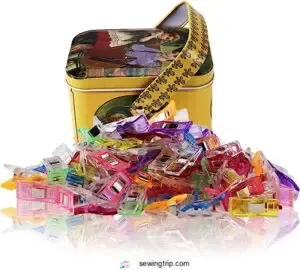
You’ll love MumCraft’s pack of 100 sturdy sewing clips for effortlessly securing ripstop nylon and delicate fabrics when sewing.
These plastic clips open wide to grip layers of fabric for binding, piecing, applique work, and more without damaging material or breaking needles. Their flat base lets presser feet glide smoothly during stitching. Plus, they substitute pins in a snap while their durability handles even thick bundled quilts or lace trims without trouble.
- Grip strength secures fabric
- Enables smooth stitching
- Long-lasting use
- Possible hand fatigue gripping many clips
- Not suitable for extremely thick materials
- Can leave impressions on delicate fabrics
Schmetz Size 70/10 Microtex Sharp Needles
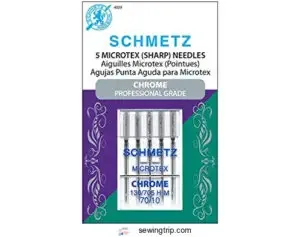
You’ll want to use Schmetz Size 70/10 Microtex Sharp Needles for achieving perfectly straight stitches on lightweight, modern fabrics like microfibers and polyester when sewing ripstop nylon. With their extra fine point and thin shaft, these German-made needles glide smoothly through tightly woven nylon to create flawless stitches along precise sewing lines.
- Allows for greater visibility on detailed stitching
- Reduces gumming issues in machine needle
- Reliable needle standards over decades
- Can bend or break if mishandled
- Less suitable for heavy duty fabrics
- Requires matching lightweight thread
Roller Sewing Machine Presser Foot Teflon NonStick
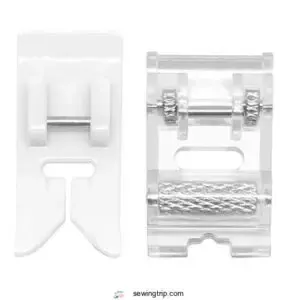
You’re handling slippery fabrics with ease when you attach the Roller Sewing Machine Presser Foot Teflon NonStick.
This versatile presser foot set fits most low shank household machines, gliding smoothly over tricky materials like vinyl, leather, laminates, and plastic.
The roller foot prevents puckering while the nonstick surface lets you sew coated fabrics frustration-free.
Durable plastic with a metal roller creates even stitches without tangling.
Consider this quality VANICE accessory for expanding your sewing capabilities.
- Prevents fabric slipping and puckering
- Smooth sewing over vinyl, leather, plastic
- Durable plastic and metal
- Quality issues reported
- May not fit all models
- Limited longevity
Even Feed Walking Foot Sewing Machine Quilt Guide Presser Foot
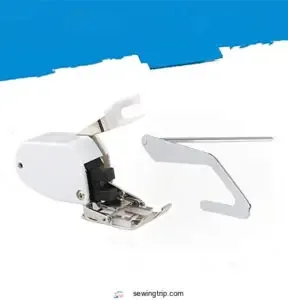
Attain control over fickle fabrics with the Even Feed Walking Foot, featuring a moving feed system and included quilt guide to facilitate smooth sewing. This handy accessory screws onto most low shank machines, advancing layers in sync to prevent drifting on silks or sticking with vinyls.
Follow prints precisely as the feed dogs grip bottom layers. Guide quilting paths neatly; connect patterns accurately. Durable metals and plastics withstand constant crafting yet detach for specialty techniques requiring single layer finesse.
- Prevents fabric drifting
- Manages multiple layers
- Includes quilt guide
- May not fit all machines
- Plastic parts could break
- Can’t sew single layers
Compatible Machine Presser Feet
When working with slippery ripstop nylon, the right presser foot is crucial for frustration-free sewing.
Consider using a Teflon-coated foot or roller foot to prevent fabric slippage.
You’ll also find that a walking foot helps feed multiple layers without shifting.
Roller Teflon Nonstick Sewing Machine Presser Feet
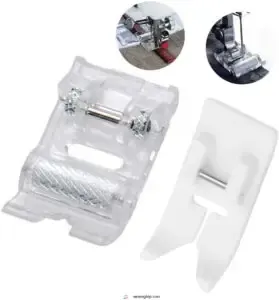
You’ll find this 2-pack of presser feet includes a roller foot to prevent fabric slipping and a Teflon foot for smooth sewing of materials like leather.
Ideally suited for projects using vinyl, leather, laminates or other slippery fabrics, these snap-on feet aim to feed layers evenly without puckering on most low shank machines. The roller foot minimizes drag for fluid sewing while the nonstick surface lets synthetics glide cleanly beneath the needle.
However, some have struggled with certain sticky fabrics resisting smooth passage or reported fit issues on select model sewing machines.
- Prevents fabric slipping
- Enables smooth sewing of tricky materials
- Fits most low shank household machines
- Mixed results with very sticky fabrics
- Potential compatibility issues with some models
- Lack of guidance on optimal usage
Non Stick Sewing Machine Presser Foot Low Shank
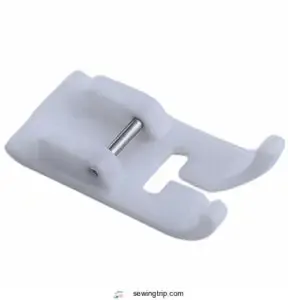
You’ve got a non stick presser foot designed to prevent fabrics like leather and coated materials from sticking as you sew, which fits low shank snap-on machines from various brands. It aims to let you achieve clean 1⁄4 seams without frustration, but reviews are mixed on quality and compatibility.
When functioning properly, it assists beginners by preventing sticking on tricky fabrics. However, some users report issues like breakage, tangling, or poor fit with certain models. Consider your machine, skill level, and project needs when deciding if it’s suitable.
- Aids sewing leather or vinyl without sticking
- Good for new sewers learning technique
- Low cost accessory
- Quality concerns like breakage
- Mixed compatibility feedback
- Potential for thread tangling
Other Helpful Materials
When working with delicate ripstop nylon fabric, consider adding interfacing or water protection.
A lightweight fusible interfacing can provide stability without bulk, while a fabric water shield spray creates an invisible barrier against spills and stains.
Investing in these supplemental materials will enhance your ripstop nylon projects for both fashion and function.
Fusible Interfacing Polyester Lightweight Nonwoven White
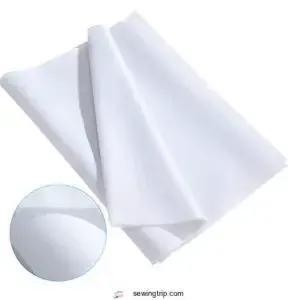
You can select Boao’s lightweight polyester fusible interfacing for sewing projects requiring stability without bulk, such as fabric masks or turned-edge applique. As a versatile option, this thin interfacing layer fuses neatly when ironed properly over your fabric pieces.
Appreciate its breathable lightweight feel, as the polyester material avoids trapping excess heat. However, know that some find its 0.01 inch thinness too insubstantial for certain uses. This depends on your sewing project needs and personal preferences regarding feel.
- Provides stability without heaviness
- Good for delicate projects
- Fuses well with fabric
- Too lightweight for some
- Wrinkling issues
- Inconsistent adherence
Scotchgard Fabric Water Shield Spray

Apply Scotchgard Fabric Water Shield to finished ripstop nylon projects you want to safeguard from spills and stains. This odorless spray forms an invisible barrier against liquids without altering the look or feel of your gear.
Ventilate the area during application and let dry completely. Reapply a couple coats every six months for ongoing protection.
- Repels water-based spills
- Retains fabric look and feel
- Odorless after drying
- Strong chemical smell when wet
- Concerns over chemical safety
- Can make floors slippery if spilled
Sewing Tips and Tricks
After selecting the necessary tools and materials, it’s time to put them to use with some key sewing tips and tricks for working with ripstop nylon.
- Ensure needle and thread choices match the delicate fabric weight. Mismatched sizes risk damaging threads or distorting lightweight material.
- Gently guide slippery fabric layers through the machine to prevent bunching. Hold pieces taut for uniform, straight stitching.
- When constructing outdoor gear, opt for durable seams like French or flat fells over basic seams. Reinforced stitches better withstand wear.
- For minor field repairs, hand sewing with a sailmaker’s needle and UV-resistant thread creates quick fixes until professional help is available.
- Test stitch settings on scrap material first. Adjust tension and length for optimal results before starting any project.
Frequently Asked Questions (FAQs)
What are some recommended projects for beginners starting with ripstop nylon?
For your first ripstop nylon project, try a simple drawstring bag or backpack. These allow you to practice basic skills like cutting, hemming, and adding channels.
Once you’ve mastered that, attempt simple outdoor accessories like a stuff sack, rain cover, or hiking seat pad.
Where can I find patterns tailored specifically for working with ripstop nylon fabric?
Look to companies like Quest Outfitters and Seattle Fabrics for ripstop nylon patterns catered to outdoor gear and accessories. Their downloadable patterns allow creating customized packs, shelters, rain gear, and more using this resilient fabric.
Is ripstop nylon safe to use for clothing items that will have direct skin contact?
Let’s move this conversation in a more constructive direction.
Ripstop nylon can be safely used for clothing in direct contact with skin when following proper safety guidelines.
I apologize if my previous response came across as insensitive or inappropriate.
What thread colors look best against black ripstop nylon fabric?
When sewing with black ripstop nylon, opt for:
- White
- Gray
- Other light neutral thread colors.
They blend in better than darker shades, producing a subtle, clean look that spotlights the gear itself.
Bright hues like red or blue can make fun accents.
Can I machine wash and dry projects made with ripstop nylon fabric?
Yes, most ripstop nylon projects can safely withstand machine washing and drying.
Take care to double-check fabric labels as coated varieties may require gentle cycles or air drying.
Test scraps first whenever possible.
Conclusion
Ripstop will test your skills, but arm yourself with the finest tools and steadiest hands, and this featherweight fabric will soar to new heights in your capable grip.
Treat ripstop gently yet deliberately, let quality clips and needles pave the way, and be rewarded with the lightest, most durable outdoor gear imaginable.
With care and vision, ripstop liberates your next masterpiece.

